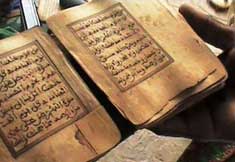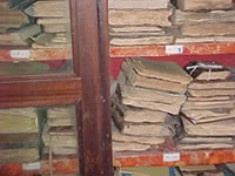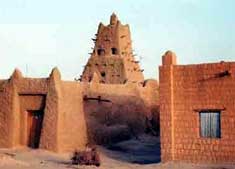Saving the Timbuktu Manuscripts
4 April 2005
South Africa has thrown its weight behind efforts to preserve the priceless Timbuktu Manuscripts, ancient documents that hold the key to some of the secrets of the continent's history and cultural heritage - and shatter the conventional historical view of Africa as a purely "oral continent".
A consortium of South African businessmen plans to build a new library to house between 200 000 and 300 000 ancient manuscripts currently housed in 24 private libraries in and around the Malian city, and to train local librarians in the preservation of a treasure trove that is threatening, literally, to disintegrate.
"Operation Timbuktu" is the first official cultural project of the New Partnership for Africa's Development (Nepad), the socio-economic revival plan of the African Union.
It is also a South African presidential project, co-ordinated by the Presidency and the Department of Arts and Culture through the National Archives in Pretoria, that aims
to make good on an offer of help to the Malian government made by President Thabo Mbeki during a state visit in 2001.
Ancient African texts
The Timbuktu Manuscripts - or Mali Manuscripts - some of which date back to the 13th century, are Arabic and African texts that hark back to city's glorious past, when Muslim merchants would trade gold from West Africa to Europe and the Middle East in return for salt and other goods.
Long-since a symbol in Western popular imagination for remote and exotic destinations, Timbuktu 500 years ago was not only a wealthy trading port, but also a centre for academics and scholars of religion, literature and science.
The manuscripts point to the fact that Africa has a rich legacy of written history, contrary to popular opinion that oral tradition alone preserved its heritage.
The largest collection of manuscripts, many from ancient libraries, is housed in the Ahmed Baba Institute, named after the
famous 15th century Timbuktu scholar Ahmed Baba. The rest of the ancient texts are housed in the private libraries of families in and around the city.
Amid fears that many of the manuscripts – vulnerable to insects and Mali's annual rainy season, albeit a short one – are deteriorating, a number of initiatives been undertaken to ensure that the priceless texts are properly restored and suitably housed.
"There have been various attempts from the US and Europe to help preserve the texts, but none really came to anything", University of Cape Town historian Shamil Jeppie told Business Day. "We hope to be the first to really help Mali in this regard."
South African involvement
Following Mbeki's offer of help in 2001, South Africa and Mali launched a trust fund to elicit funds from the public both to upgrade the Ahmed Baba Institute and to finance the building of a new library equipped with the necessary technology to preserve the
manuscripts.
South Africa also began sharing with Mali its own technical expertise on preserving ancient documents: training programmes for Malian archivists have started at South African institutions
Last month, Jeppie led a team of South African architects and engineers to Mali to evaluate the project to build a new library.
Adam Essa, director of project developers Coessa Holdings, told Business Day that the facility would be built opposite the historic Sankore mosque, close to Timbuktu's old quarter, a Unesco World Heritage Site. Construction, he said, could begin as soon as December.
According to Jeppie, the cost of building the library - estimates put it in the region of R13.5-million - will be borne entirely by the companies involved, along with a hoped-for R5-million boost from a gala fundraising banquet taking place at the Cape Town International Convention Centre on 8 April.
Local businesses have been invited to "buy in" to the project by
sponsoring tables at the dinner, which will be hosted by Mbeki and Western Cape Premier Ebrahim Rasool.
"Those who pay the most will have their own table and will be sitting with the President, others with Minister of Finance Trevor Manuel, MECs, the mayor, etc", Rasool said. (Those interested can contact Edel on 021 483-4212 or 083 369-3151.)
Western Cape financial services group Oasis has already pledged R3.5-million to the project, Business Day reports.
The 'song and dance' stereotype
Widespread interest in the Timbuktu Manuscripts was kindled in 1999 when an American professor of religion and history, John Hunwick, came across some of the documents in an old trunk in a family library in Timbuktu.
Hunwick was keen to show how the documents pointed to the existence of written records of Africa's civilisation.
Where previously the continent was thought to have relied on "oral tradition" alone to pass on its history, the
texts show a wealth of documentation - manuscripts, letters, books - on issues as wide-ranging as justice, religion, philosophy and history from hundreds of years ago.
"Africa has for too long been stereotyped as the continent of song and dance, where knowledge is only transmitted orally", Hunwick said at the time. "We want to demonstrate that Africans think and write and have done so for centuries."
According to Jeppie, who has seen some of the manuscripts, they include mathematical and scientific texts covering astronomy, medicine and geomancy.
While most are in Arabic, some are in indigenous languages such as Songhai and Hausa, written using Arabic script.
Centre of trade and scholarship
Timbuktu was founded in around 1100 by ethnic Tuareg nomads near the northern-most bend of the Niger River. Their caravans took salt from Saharan mines to trade for gold and slaves, transported along the river from the south, and by 1330
Timbuktu was part of the Malian empire.
Two centuries later the city was at the height of its grandeur under the Songhai empire. Timbuktu was described by Spanish Moor Leo Africanus as a centre for "doctors, judges, priests and other learned men (who) are bountifully maintained at the king's expense".
It was also a centre of learning, where thousands of students were taught and large private libraries kept.
But Timbuktu's fortunes sank in 1591 when Songhai was defeated by a Moroccan army. When Portuguese explorers discovered new trade routes along the West African coast, Mali was sidelined. Under France's rule the country continued to slide into poverty and isolation.
Shining a light on the future
While Timbuktu remains a poor, dusty city, visitors still flock there today to experience the aura of mystique and legend that surrounds it.
And it is still home to many philosophers and scholars of Islam, with Sankore
University catering to some 15 000 students.
Growing involvement from several countries, including South Africa, in helping to preserve the legacy of Timbuktu, have kindled new interest in the city.
According to Timbuktu philosopher and historian Ismael Diadie Haidara, Timbuktu was inhabited for hundreds of years by Muslims, Christians and Jews, who lived together in peace up until the end of the 19th century.
The city may be steeped in history, but Haidara believes it could also shine a light on the future.
SouthAfrica.info reporter


| 


















